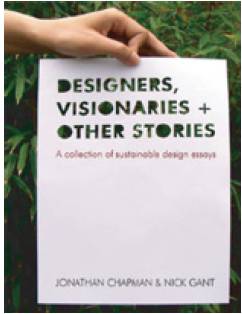It starts off with no other than Alastair Fuad-Luke, Re-defining the Purpose of (Sustainable) Design. He declares that “Designers urgently need to move beyond the confines of aesthetic fascism and fetishism tied to the purpose of money making”. His solutions are to ‘co-design’ in order to trigger new outcomes and to spark design ideas “with, for and by society”. And yes, there’s that part where Fuad-Luke questions whether co-design can be applied to commercial products.
The next chapter is entitled Design Redux by Stuart Walker. The question he asks designers to find answers to is: “How can we live decently?” To answer this question, Walker suggests changing the process of that used in design schools today, away from paper- or computer-based communicating methods, towards “intuitive, hands-on, physical and reciprocal methods that respond to the world as it is”. Applying this new strategy to existing objects, not only leaves us with aesthetically pleasing result but also with a responsibility to the environment and social equity. Walker picked several existing products to show how they can be incorporated into a new functional design.
The following chapter is by Ezio Manzini, “the godfather of sustainable design” as Nick Gant called him! Its title: the Scenarios of Multi-Local Society makes it clear that it’s about creative communities, active networks and enabling solutions. Manzini is proposing a scenario building exercise, introducing cases of social innovation in order to create a “newand practical vision of a sustainable future: the multi-local society”. Titles like “Small is not small and local is not local” definitely promise interesting points of views John Wood wrote about Relative Abundance and Fuller’s Discovery that the Glass isglazing, pose an intractable problem for designers. The façade is always bi-directional in that energy transfers in both directions simultaneously.
- Lighting Systems : The production of artificial (electrical) light is the most inefficient process in a building. As such, there has been a concerted effort to improve the efficiency of the individual lamps.
- Energy Systems : There are three types of energy needs in a building: thermal, mechanical and electrical. Thermal energy is necessary for heating and cooling of spaces, refrigeration, water heating and cooking. Mechanical energy is necessary for fans, motors, compressors, pumps and many appliances. Electrical energy is only directly required for lighting and peripheral equipment such as televisions and computers.
- Structural Systems : Structures behave in complex ways when subjected to forces that originate externally to the structure (winds, earthquakes) or are due to its use context, or even its own dead weight. Specific members, for example, bend or tend to buckle. ( Piezoelectric )
Always Full. Wood analysed “why we are in such a mess”, by looking at what designers created before and after 1927 when Coca Cola introduced the first non-refundable bottle, until today, where “designers have failed to live up to their full potential in regards to the environmental impacts”. Woods question he’s trying to answer is therefore “not what kind of skills designers need, but what is their deep, long-term purpose and potential in upholding the well-being of the biosphere as a whole?”
The chapter Clothes that Connect is written by Dr Kate Fletcher. Fletcher, a leading specialist in sustainable fashion and textile, believes that “fashion is eating itself ”. She describes how fashion has disconnected itself from reality and its pressing problems such as climate change and poverty. These subjects don’t normally make it to the catwalk, until now, where “fashion is transforming itself ”. Fletcher says “we are living in changing times: Tiny companies are making shareable clothes tuned to alternative models of social activism and giant companies are announcing plans to go carbon neutral and introducing Fairtrade cotton.” In this book, Fletcher presents her conceptual project “5 Ways”, based on the key points: Local, Updatable, No Wash, Nine Lives and Super Satisfiers.
This book review was written by: Anil Kumar Bhaskar


Leave a Reply
You must be logged in to post a comment.